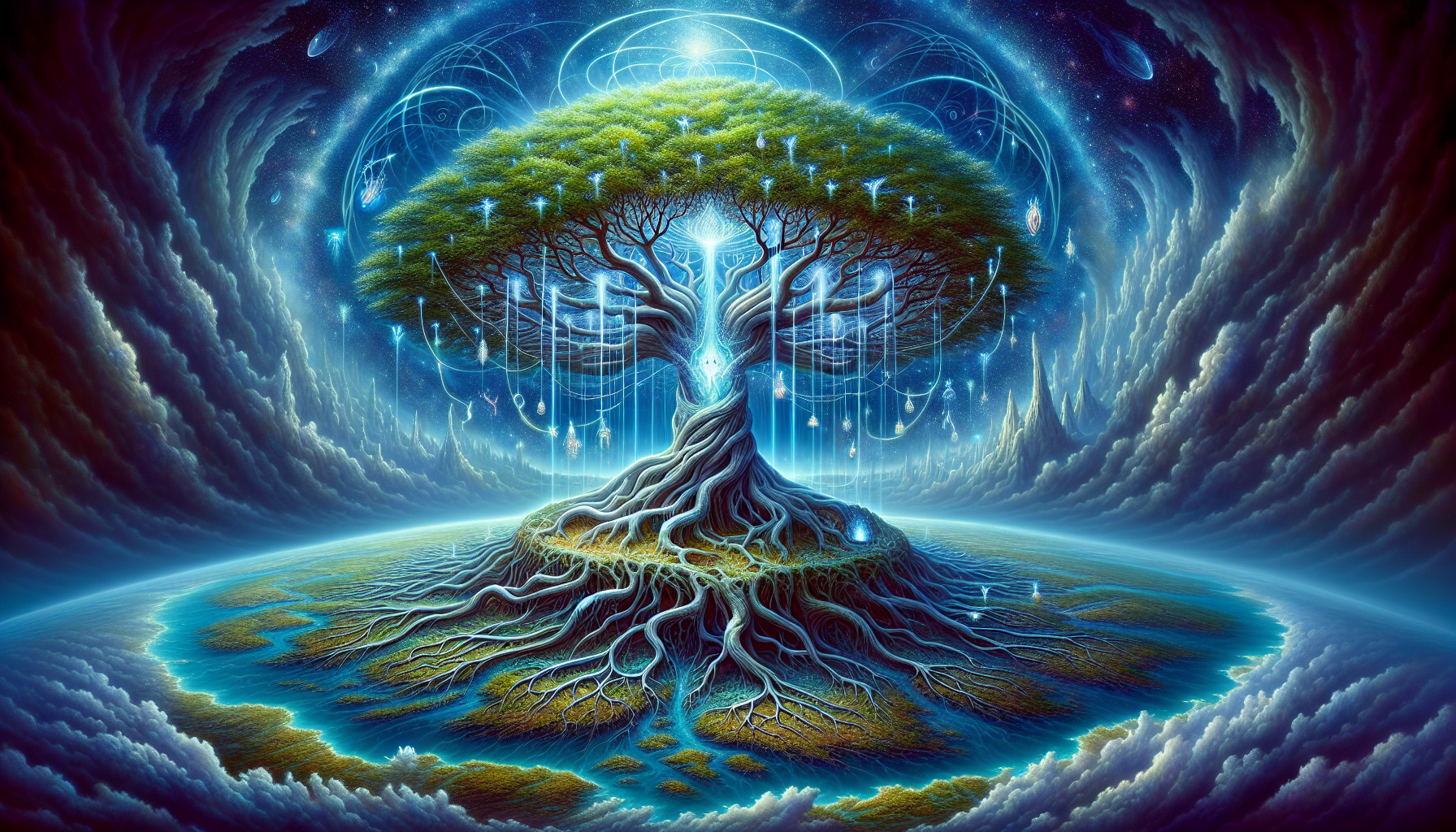Title: Axis Mundi
Author: Alloya Huckfield
Description: Discover the profound concept of the Axis Mundi, the sacred "world axis" connecting heaven, earth, and the underworld. Explore its manifestations in mountains, trees, temples, and human spirituality across cultures, revealing humanity's quest for cosmic order and transcendence.
tags:
- Axis-Mundi
- world-axis
- cosmic-pillar
- Yggdrasil
- AbZu
- Mount-Meru
- TREE-OF-LIFE
icon: LiAsteriskthe-axis-mundi

The Axis Mundi represents one of humanity's most profound and widespread sacred concepts. Translating literally from Latin as "the axis of the world," this concept appears across diverse cultures and religious traditions throughout human history, serving as a foundational element in how people conceptualize the structure of reality. At its essence, the Axis Mundi represents the center point that connects different realms of existence. It typically takes the form of a vertical line or column that links:
- The celestial realm above (heaven, the divine world)
- The terrestrial realm of human existence (middle earth, the world of living beings)
- The chthonic or underworld realm below (the realm of the dead or primordial forces)
This cosmic axis serves as a conduit between these realms, allowing for communication, travel, or influence between different levels of existence. For humans, it represents the point where the sacred breaks through into the profane world—where the eternal touches the temporal.
What makes the Axis Mundi particularly fascinating is its appearance across virtually all human cultures, though expressed through different symbolic forms:
In architecture and sacred spaces, the Axis Mundi takes many forms:
- Mountains: Natural mountains like Mount Meru in Hindu cosmology, Mount Olympus in Greek tradition, or Mount Fuji in Japanese Shinto represent physical manifestations of the world axis. These mountains were understood not just as geological features but as the actual center point of creation.
- Trees: The cosmic tree appears repeatedly across cultures—Yggdrasil in Norse mythology connects nine worlds; the Tree of Life in Kabbalah links divine emanations; the Bodhi Tree in Buddhism marks the spot of enlightenment. These sacred trees often have roots extending into the underworld and branches reaching toward heaven.
- Pillars and Columns: From totem poles of indigenous North American peoples to the djed pillar in ancient Egyptian religion to the stupa in Buddhist architecture—vertical structures often symbolize the cosmic axis.
- Buildings: Temples, ziggurats, pagodas, and cathedrals frequently embody the Axis Mundi principle. Their vertical orientation, often with a central pillar or spire, creates a symbolic connection between earth and heaven. The placement of altars, shrines, or sacred objects at their center intensifies this symbolism.
- Poles and Staffs: The shaman's staff, the maypole, the caduceus, and similar vertical ritual objects represent portable versions of the cosmic axis, allowing ritual specialists to establish sacred center points temporarily.
Beyond physical representations, the Axis Mundi appears in more abstract conceptual forms:
- Omphalos or "Navel of the World": Many cultures identify a specific location as the world's center—the point from which creation expanded outward. The Temple in Jerusalem, Delphi in Greece, Cusco in the Inca Empire, and numerous other sacred sites have been designated as the cosmic center.
- The Human Body: In many traditions, the human spine serves as a microcosmic axis mundi. In yoga and Tantric practices, the central channel (sushumna nadi) along which kundalini energy rises parallels the cosmic axis.
- Calendrical Systems: Some cultural understandings of time incorporate the axis mundi concept. The Mayan calendar system, for instance, viewed certain moments as "axis points" when the boundaries between worlds became permeable.
By establishing a fixed center point, the Axis Mundi provides:
- Cosmic orientation—a way to locate oneself within the larger structure of reality
- A reference point from which cardinal directions derive meaning
- A principle of order that transforms chaotic space into ordered, meaningful cosmos
An axis mundi creates a break in homogeneous space, distinguishing sacred from profane areas.
The Axis Mundi facilitates interaction between realms:
- Gods or divine messengers can descend to earth along this axis
- Prayers and offerings from humans ascend to higher realms
- Shamans, priests, and mystics can symbolically travel along this axis during rituals or trance states
Proximity to the Axis Mundi often confers transformative potential:
- Pilgrimage to axis points (sacred mountains, temples) brings spiritual merit
- Meditation practices that visualize internal alignment with the cosmic axis facilitate spiritual transformation
- Ritual circumambulation around axis points (like circling the Kaaba in Islam) creates participation in cosmic order
The persistence of this symbol across times, cultures, and contexts points to something fundamental in human consciousness—a need to establish meaningful centers that connect our immediate experience to larger frameworks of meaning. By recognizing the various manifestations of the Axis Mundi, we gain insight into how humans across history have oriented themselves within the cosmos and established connections between their everyday experience and transcendent realities. The Axis Mundi continues to provide a powerful metaphor for understanding how we locate ourselves in physical, social, and spiritual space.